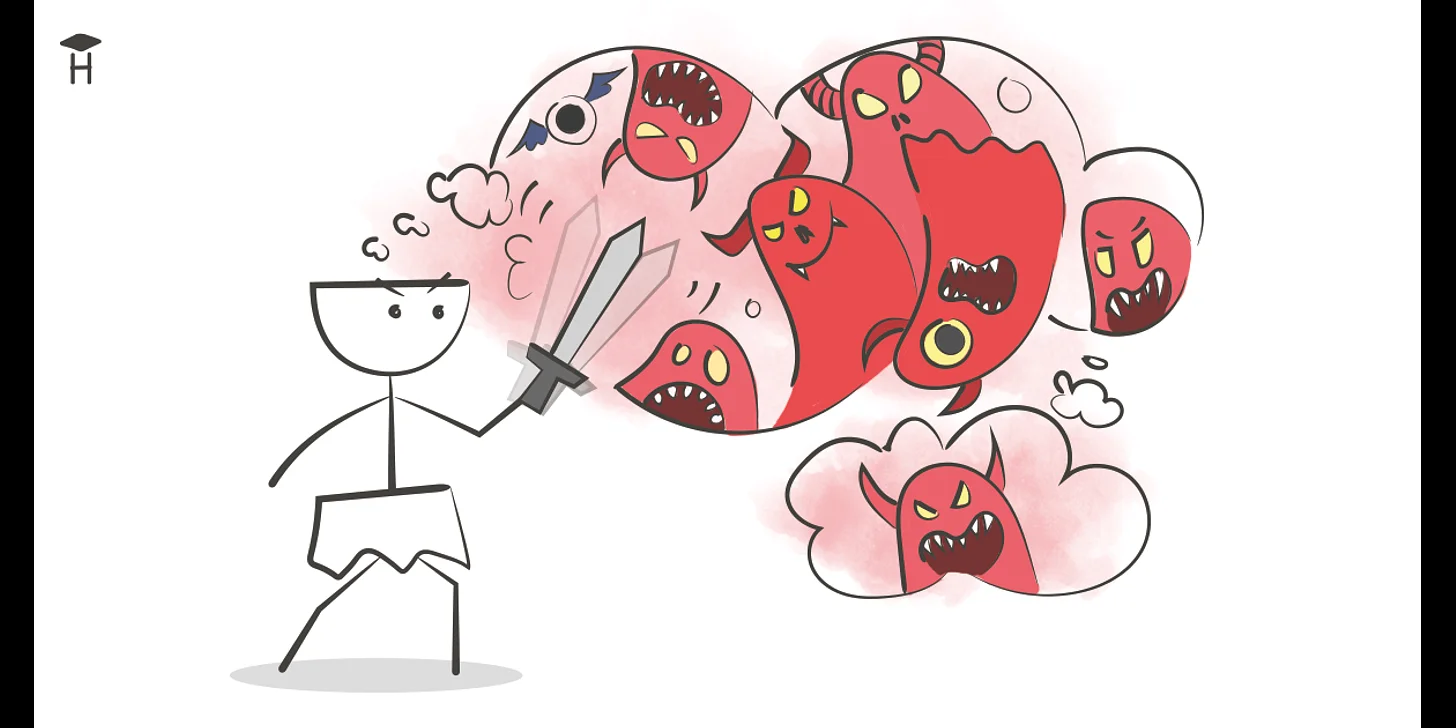How to Learn to Cope with Negative Thoughts

Fitting active and regular exercise into your daily schedule may seem difficult, at first your body will resist: aching muscle pain, fatigue, unwillingness to continue. If you go for a run for the first time in decades, the body will clearly tell you: “you don't need to do this”. This is a natural reaction. An evolutionary defense tool against overloads and hazards.
Any physical exercises or sports classes teach people to cope with this reaction and create their workout routine by listening to their body needs.
If you start active and regular mental exercises (for example, learning programming), then, at first, your brain will resist it. The brain has much more resistance tools than the muscles: it can plant thoughts that you're incompetent, that "this is not mine, and it's better for me to do something else," or "I don't have a mathematical mindset" and so on.
This article is about mental resistance to problems and how to overcome them. It consists of four steps:
- Self-awareness. Notice, be aware, become a scientist
- Mindset. Understand what success depends on
- Openness. Exclude one of the main conditions of mental block
- Progress. Accept the realities of the learning process.
Contents
Step 1: Self-awareness
First of all, it’s necessary to sharpen your awareness of emerging mental resistance. Treat your body and mind as a scientific experiment: they give you, the observer, some signals, then they react to actions and environment.

Try to notice or even write down the conditions under which such thoughts typically occur. A lot of things affect the mental state, including physical condition, work environment, sleep, nutrition, stress, goals, relationships, etc.
Keeping a journal can be a good idea. Write everything about your everyday life: how much you sleep, what you do, what you eat, how much you read, how you relax, and how is your training going.
It will be great if you can identify the reasons for good and bad days. Sleeping less than 7 hours plus meeting someone before lunch almost always have something with learning problems. Or physical activity and reduced consumption of sweets have something with successful training. Perhaps this is not a mere correlation, but a causality.
Do your own experiments and feel like a scientist.
Step 2: Mindset
Carol Dweck, Stanford University psychologist, identified two core mindsets: fixed mindset and growth mindset.

Mindset is a collection of beliefs, ideas and concepts held by oneself.
Fixed mindset is characterized by such beliefs:
- I am who I am and people don't change
- success relies on innate talent
- people fit into specific categories: techies, humanitarians, strong and weak, smart and stupid, etc.
- I should avoid changes and challenges to prevent the possibility of failure
- efforts are worthless
- I need to choose a path of the least effort
- being criticized is bad
- I have every right to complain about problems and failures
Growth mindset is characterized by such beliefs:
- I’m able to change, my abilities and intelligence can be developed over time if I put my mind to it
- success can be achieved through effort
- categories of people are more likely approximate descriptions of the current state or areas of interest, they don't define anyone's fate
- I willingly embrace challenges, it’s an opportunity to grow
- effort leads to mastery
- I believe failures are just temporary setbacks and learning opportunities
- constructive feedback as a source of information
- complaints make no sense and distract from the things that really matter
You can notice a recursive trap: fixed mindset makes a person think that his fate is predetermined and he won’t be able to change.
Studies of mindsets lead to an interesting conclusion: the quality of life and satisfaction depend more on a subjective attitude, and not on talent or intelligence. In other words, a person can develop a growth mindset with beliefs and rational evidence.
Use your emotional resistance ("probably, this is not my thing", "it's obvious that I'm not a tech guy...", "I would never make it as a programmer") as a starting point in your mindset transformation.
Resistance, problems and failures aren’t going anywhere. Any professional who has achieved something has thousands of times more problems and failures than a beginner who has given up. They are distinguished primarily by their attitude to these problems.
It's fine to feel resistance. This is a sign of growth. Don't miss the opportunity to grow.
Step 3: Openness
Forget the myth that hard work and tons of books you've read will make you an expert. The shortest way to get into learning stagnation is to isolate yourself from other students and teachers.

- Ask questions. If you learn programming at Hexlet you will get an answer anyway — our mentors answer all questions after each lesson. Formulating a question also helps to sort everything out and bring you closer to a solution. An abstract problem in the head and the one put into text are different things.
- Communicate. You might call yourself an extrovert or an introvert, but every person needs socializing more or less, and this is crucial in studying. It is very helpful to find other people with similar problems to yours, to know about their progress and experience. Hexlet has a big friendly chat for this purpose.
- Accept and share your experience. Find someone who is in a similar situation or under the same conditions. Right now someone like you is trying to learn programming or a new language. Someone is experiencing similar difficulties. Consider starting your own blog.
Step 4: Progress
The process of exploring new areas can sometimes seem too slow or even endless. In the essay "The Learning Process" I had an interesting analogy describing the process of learning new subjects. I recommend you to read it if you ask yourself the same questions:
- Which book should I start with?
- I kind of understood each topic separately, but I simply don't get how they are connected. And why did I even study it, it makes no sense to me.
- I study a lot but that's not really helping!

I also advise you to read Kirill Mokevnin's article on effective reading of professional literature.
A temporary lack of visible progress is OK but a long-lasting one is a sign of serious problems. For example, if after six months of learning programming you still can't write and run a simple program, it's about time to make changes to the learning process. Try as soon as possible (it doesn't have to be perfect!) to create your own project, application, website, etc.
A good strategy is to keep track of progress by recording your goals, progress and successes. Review it from time to time and compare yourself with your past self. If you find past problems a little funny or you are even a bit embarrassed — that's awesome! You've obviously grown up. If the old problems haven't gone away, then it's worth changing the approach, conditions and tools of training.
As it often happens, all such topics can be summed up in a short ancient Greek saying: γνῶθι σεαυτόν — know yourself.
References
I recommend you these books if you'd like to learn more about the subject:
Valeriya Belyakova
a year ago
1
